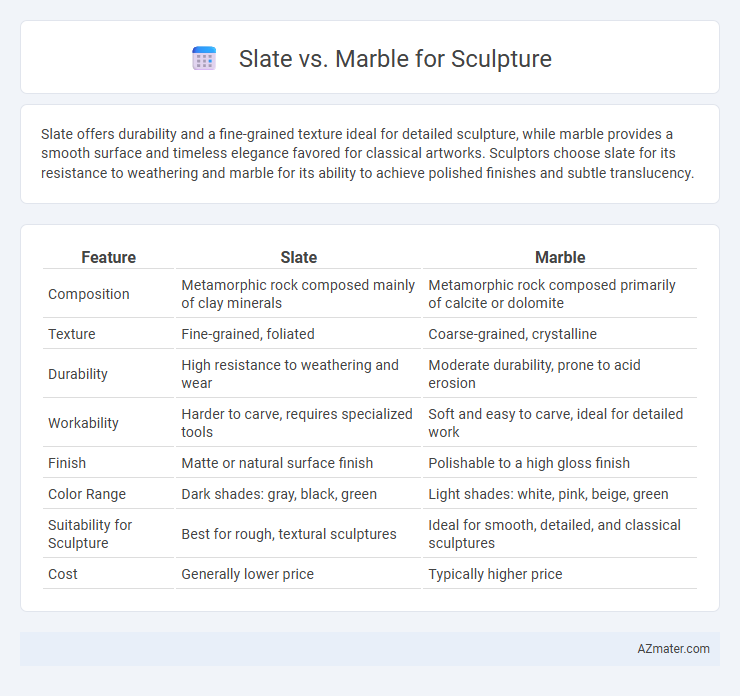Slate offers durability and a fine-grained texture ideal for detailed sculpture, while marble provides a smooth surface and timeless elegance favored for classical artworks. Sculptors choose slate for its resistance to weathering and marble for its ability to achieve polished finishes and subtle translucency.
Table of Comparison
| Feature | Slate | Marble |
|---|---|---|
| Composition | Metamorphic rock composed mainly of clay minerals | Metamorphic rock composed primarily of calcite or dolomite |
| Texture | Fine-grained, foliated | Coarse-grained, crystalline |
| Durability | High resistance to weathering and wear | Moderate durability, prone to acid erosion |
| Workability | Harder to carve, requires specialized tools | Soft and easy to carve, ideal for detailed work |
| Finish | Matte or natural surface finish | Polishable to a high gloss finish |
| Color Range | Dark shades: gray, black, green | Light shades: white, pink, beige, green |
| Suitability for Sculpture | Best for rough, textural sculptures | Ideal for smooth, detailed, and classical sculptures |
| Cost | Generally lower price | Typically higher price |
Introduction to Slate and Marble in Sculpture
Slate and marble are both popular stones in sculpture, valued for their distinct characteristics and aesthetics. Slate is a fine-grained, foliated metamorphic rock known for its durability and matte finish, making it ideal for intricate, textured works. Marble, a crystalline metamorphic rock primarily composed of calcite, offers a smooth, polished surface and subtle veining that enhances sculptural detail and elegance.
Historical Use of Slate and Marble in Art
Marble has been a preferred material for sculpture since ancient times, renowned for its fine grain and translucency that allows for intricate detail and lifelike representations, notably used by classical Greek and Roman artists such as Michelangelo. Slate, while less common in classical fine art, has historical significance in folk and vernacular sculptures, prized for its durability and ability to be split into thin, smooth sheets suitable for stylized carvings and architectural elements. The contrast in historical use highlights marble's association with high art and monumental sculptures versus slate's functional artistry in regional craftsmanship.
Physical Properties: Slate vs Marble
Slate exhibits a fine-grained, foliated texture with high cleavage, making it easier to split into thin, smooth sheets, while marble possesses a coarser, crystalline structure with interlocking calcite crystals that provide greater durability and a smoother finish. Marble's density typically ranges from 2.6 to 2.8 g/cm3 compared to slate's lower density of about 2.7 g/cm3, affecting the weight and stability of sculptures. The hardness difference is notable, with marble scoring around 3-4 on the Mohs scale, allowing for finer detail and polish, whereas slate scores around 3, offering moderate resistance to weathering and shaping constraints.
Workability and Sculpting Techniques
Slate offers superior workability for sculpture due to its fine-grained, foliated texture, allowing for precise chiseling and smooth shaping with hand tools. Marble's crystalline structure demands advanced techniques such as pointing and rasping, enabling detailed carving but requiring more skill and time to achieve fine finishes. Sculptors often prefer slate for intricate, angular designs, while marble suits fluid, classical forms because of its ability to hold delicate details and a polished surface.
Durability and Longevity
Slate exhibits excellent durability, resisting weathering and wear due to its fine-grained, foliated structure, making it ideal for outdoor sculptures that endure harsh conditions. Marble, while prized for its aesthetic appeal and smooth texture, is more susceptible to erosion and acid rain, compromising longevity in outdoor environments. Sculptors seeking long-lasting, low-maintenance materials often prefer slate for its superior resistance to physical and chemical deterioration.
Aesthetic Appeal and Finishes
Slate offers a fine-grained texture and natural matte finish that enhances intricate details and provides a modern, understated elegance in sculptures. Marble's smooth surface and translucent quality create a classic, lustrous appeal that highlights curves and depth with polished or honed finishes. Both materials allow versatile finishing techniques, but marble's reflective surface often brings a more luxurious and timeless aesthetic compared to slate's rugged, organic charm.
Cost Factors: Slate vs Marble
Slate generally offers a more cost-effective option for sculpture compared to marble, with prices ranging from $2 to $5 per square foot versus marble's $10 to $30 per square foot. Slate's lower cost is due to its abundant availability and easier quarrying process, while marble's higher price reflects its rarity and labor-intensive extraction. Maintenance expenses for marble are also higher due to its susceptibility to staining and acid damage, increasing the overall investment for sculptors.
Popular Sculptures and Notable Artists
Slate, favored for its fine grain and natural cleft surface, has been prominently used in sculptures like the delicate works of Tim Bumble, known for his intricate slate figurines. Marble, prized for its smooth texture and ability to hold fine detail, features prominently in iconic sculptures such as Michelangelo's David and works by Auguste Rodin, showcasing its enduring appeal among master sculptors. Popular sculptures made from marble often highlight classical themes, while slate sculptures tend to emphasize contemporary and abstract forms.
Environmental Impact and Sourcing
Slate, primarily composed of fine-grained metamorphic rock, generally has a lower environmental impact due to its abundant natural deposits and less energy-intensive quarrying processes compared to marble. Marble extraction involves extensive quarrying, resulting in significant landscape disruption and higher carbon emissions due to its heavier processing and transportation requirements. Both materials' sourcing practices can influence local ecosystems, but slate's durable and abundant nature often makes it a more sustainable choice for environmentally conscious sculptors.
Choosing the Right Stone for Your Sculpture
Selecting between slate and marble for sculpture hinges on desired texture, durability, and visual impact. Marble offers a smooth, polished surface with translucent qualities ideal for intricate details and classical elegance, while slate provides a rugged, matte finish that highlights natural layering and is suited for bold, modern designs. Understanding the stone's hardness, weather resistance, and workability helps sculptors align their artistic vision with practical material properties.

Infographic: Slate vs Marble for Sculpture
 azmater.com
azmater.com